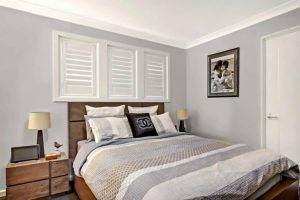Plantation shutters were originally designed for stately homes in the southern states of America, where winters are mild, but summers are extremely hot and humid. Traditional window furnishings, like curtains, became far too stifling in the subtropical climate, and so the plantation-style shutter was developed.
With signature wide slats, plantation shutters allow for more airflow. The permanence as wall fixtures also removes any need to swap in seasonal window covers. Overall, the simplicity of the design is not only timeless; it goes with any style of interior, from contemporary to industrial.
Plantation shutters aren’t just universally charming. They have a lot of other attractive selling points that go far beyond being stylish.
The shutters were initially designed to keep the sun’s harsh rays and subtropical heat out of colonial-era American homes. Plantation shutters, with their large slats, allow for greater airflow when they are open, but when they are closed, are excellent insulators and can help homeowners save money on heating and cooling expenses by helping to regulate the interior temperature of the house. Many shutters are also made from non-toxic and recyclable materials that help you reduce your carbon footprint.
Plantation shutters are built to last and become permanent fixtures on windows. Many are made with wood, PvC (plastic) or Insulite and are meant to stand the test of time. The shutters wide slats and simple materials also make cleaning a breeze. A quick dust or a wipe-down with a damp cloth is often all that is needed to keep the shutters looking fresh and new over time.
The simple design of plantation shutters remains timeless. Plantation shutters are sleek and unassuming. They don’t fight for attention with other design elements and are rather neutral in appearance. Plantation shutters can fuse easily with modern, industrial, vintage, or shabby chic designs. They also remove the need to constantly update your window furnishings. A plantation shutter doesn’t need constant re-modeling or re-styling, saving you time and money during renovations, room updates, or seasonal interior design changes.
Since most window coverings are temporary and easily removable, they don’t end up adding any value to your home. Plantation shutters, however, are permanent fixtures. The shutters are created specifically to fit your windows and improve the overall design of your home. They add curb appeal as well as energy savings that can boost the resale value of your home when you’re ready to sell.
Plantation shutters offer an efficient way to shield your rooms from direct sunlight. You can control the amount of light you let in by adjusting the angle of the slats. This makes it easier to protect indoor possessions and furniture from the damage of extreme sun exposure over time.
The cost of your plantation shutters will vary.Three main factors usually determine the pricing: :
Different types of plantation windows have a variety of pros and cons. They also may require different maintenance techniques. Each has their specific look and feel that should be considered. Once again, the least expensive isn’t necessarily the best. Plantation shutters are meant to stand the test of time – if you invest in quality at the outset.
Here’s a breakdown of what to expect from the three main types of plantation shutter materials:
The Benefits

The Downsides
Cost
In terms of price, wood is far and above more expensive than either plastic and Insulite. What’s more, due to the fact that wood needs to be repainted or restained over its lifetime, there’s an added cost of maintaining the wood itself.
Maintenance
The shutters may need a fresh stain or coat of paint every ten years or so. To keep your shutters well maintained ensure they are free from dust. Wipe them over with mild detergent and water to help keep them clean and looking their best. Wood is prone to warp due to the effects of moisture, so be sure to watch for signs of excess water near the shutters that can affect the wood over time.
The Benefits
The Downsides
Cost
Plastic is the least costly option when it comes to installing plantation shutters. However, not all plastics are made equal, and quality can vary widely. If the price is too good to be true, it probably means your shutters are not likely to stand the test of time.
Maintenance
Any mild detergent will easily clean your plastic plantation shutters. Simply wipe them down with a damp cloth to keep them looking their best.
The Benefits
The Downsides
Cost
Insulite is a good middle ground between wood and plastic. Due to its longevity and its environmental friendliness, the investment holds its own over time. The up-front costs aren’t as high as wood, and you are getting a more quality product than you would with even the highest quality plastic option.
Maintenance
Insulite shutters have some of the longest shelf life in the industry, meaning your shutters are built to last.
Insulite is very easy to clean. A simple wipe down with a damp cloth or a quick wash with a mild detergent will keep your shutters looking like new.
Insulite plantation shutters are perfect for all locations around Australia. Their ability to withstand all Australian climates makes them perfect for cooler climates like Victoria and Tasmania while also withstanding hotter more tropical climates like Queensland.
Insulite Planation Shutters are available in:
NSW: Sydney, Newcastle and Central Coast
VIC: Melbourne
TAS:Tasmania
QLD: Brisbane
SA: Adelaide
WA: Perth
Contact the team at Modern to find out about our unique Insulite plantation shutters.
Get up to 50% off on Selected Stock